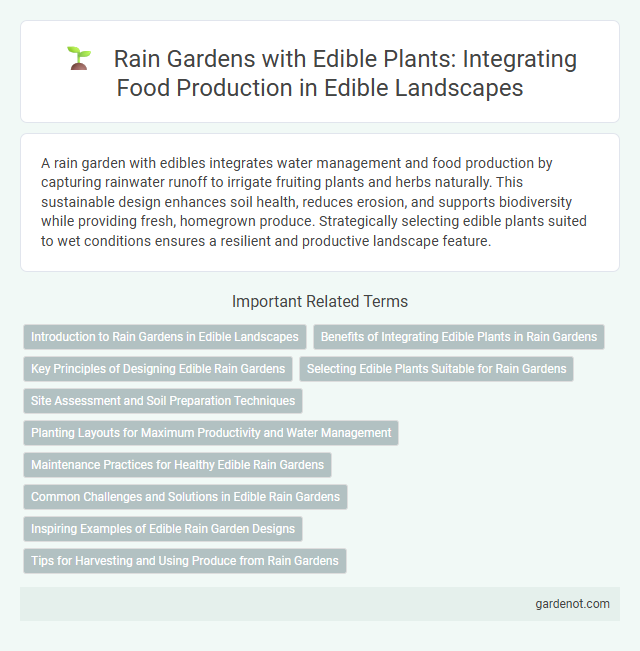A rain garden with edibles integrates water management and food production by capturing rainwater runoff to irrigate fruiting plants and herbs naturally. This sustainable design enhances soil health, reduces erosion, and supports biodiversity while providing fresh, homegrown produce. Strategically selecting edible plants suited to wet conditions ensures a resilient and productive landscape feature.
Introduction to Rain Gardens in Edible Landscapes
Rain gardens in edible landscapes serve as sustainable water management systems that capture and filter rainwater while supporting the growth of fruits, vegetables, and herbs. These gardens use native plants combined with edible species to improve soil health, reduce runoff, and create productive green spaces. Incorporating rain gardens enhances biodiversity, conserves water, and yields fresh, homegrown food in urban and residential settings.
Benefits of Integrating Edible Plants in Rain Gardens
Integrating edible plants in rain gardens enhances biodiversity while providing fresh fruits and vegetables, improving food security. These plants support natural water filtration by absorbing excess runoff, reducing soil erosion and nutrient pollution. Moreover, edible rain gardens create sustainable ecosystems that promote pollinator habitats and enrich urban green spaces.
Key Principles of Designing Edible Rain Gardens
Rain gardens with edible plants integrate stormwater management and food production by capturing runoff while enriching soil fertility for fruit, herbs, and vegetables. Key principles include selecting native, drought-tolerant edible species adapted to local hydrology, creating graded basins for water retention, and incorporating rich organic soil layers to enhance nutrient availability. Strategic plant placement maximizes sunlight exposure, runoff absorption, and harvest accessibility, ensuring ecological resilience and sustainable yield.
Selecting Edible Plants Suitable for Rain Gardens
Choosing edible plants for rain gardens requires selecting species that thrive in moist, well-drained soil and can tolerate occasional flooding. Ideal options include water-tolerant herbs like mint and lemon balm, vegetables such as kale and chard, and fruits like blueberries and strawberries that adapt well to fluctuating hydration levels. Incorporating native edible plants helps support local ecosystems while ensuring plant resilience and sustainability in rain garden environments.
Site Assessment and Soil Preparation Techniques
Rain gardens with edibles require thorough site assessment to evaluate drainage patterns, water flow, and sunlight exposure essential for plant health. Soil preparation involves amending with organic matter, ensuring proper aeration, and adjusting pH levels to support both moisture retention and edible plant nutrient needs. Testing soil permeability and nutrient content optimizes the garden's capacity to retain rainwater while fostering robust growth of vegetables and herbs.
Planting Layouts for Maximum Productivity and Water Management
Rain gardens with edibles are designed to capture runoff, enhancing water efficiency and supporting plant health. Optimal planting layouts incorporate deep-rooted perennials alongside shallow-rooted herbs to maximize root zone utilization and nutrient absorption. Incorporating contouring and layered vegetation promotes effective water infiltration while increasing overall edible yield.
Maintenance Practices for Healthy Edible Rain Gardens
Maintaining a rain garden with edibles requires regular monitoring of soil moisture to ensure adequate hydration without waterlogging, promoting healthy root development. Incorporating organic mulches reduces weed growth and conserves moisture, while periodic fertilization with compost supports nutrient-rich soil essential for edible plants. Pruning and removing diseased foliage prevent pest infestations and enhance airflow, sustaining vigorous plant growth in edible rain gardens.
Common Challenges and Solutions in Edible Rain Gardens
Edible rain gardens often face challenges such as waterlogging, soil erosion, and pest infestations, which can hinder plant growth and crop yield. Implementing well-draining soil mixtures, incorporating native plants alongside edible species, and using organic pest control methods help address these issues effectively. Properly designed rain gardens with layered plantings and mulching improve water absorption and nutrient retention, promoting healthier edible landscapes.
Inspiring Examples of Edible Rain Garden Designs
Rain gardens integrated with edible plants showcase innovative landscaping that maximizes water conservation and food production simultaneously. Examples like the urban rain garden in Portland incorporate native berries, herbs, and vegetables, enhancing biodiversity and providing fresh produce while managing stormwater runoff effectively. These designs demonstrate sustainable practices by combining functional rainwater harvesting with productive, edible landscapes.
Tips for Harvesting and Using Produce from Rain Gardens
Harvest produce from rain gardens when fruits and vegetables reach full color and firmness, ensuring peak flavor and nutrient content. Use clean, sharp scissors or garden shears to avoid damaging delicate plants and prevent disease spread. Incorporate harvested edibles into fresh salads, homemade preserves, or smoothies to enjoy garden-to-table freshness while promoting sustainable water management.
Rain garden with edibles Infographic

 gardenot.com
gardenot.com